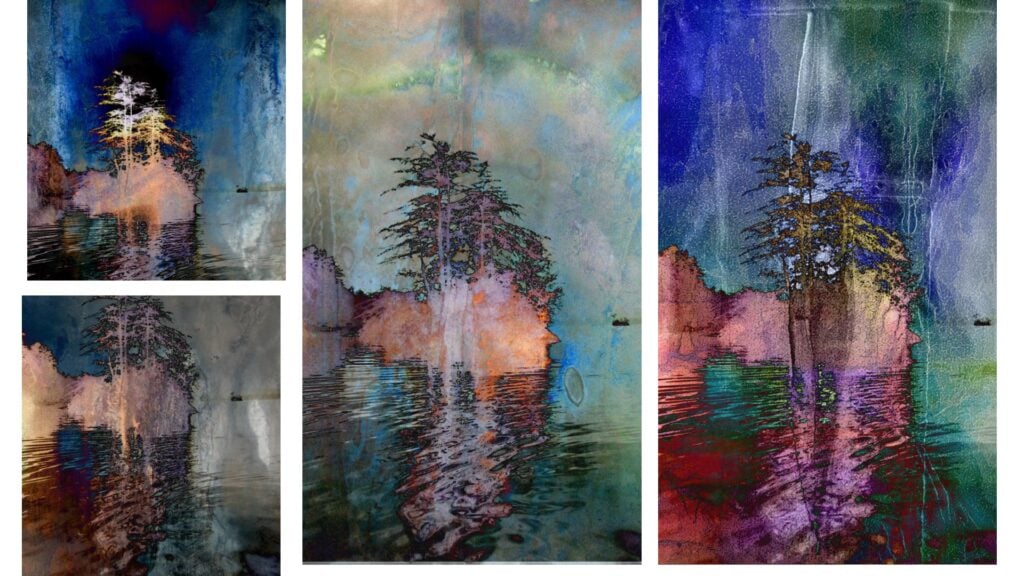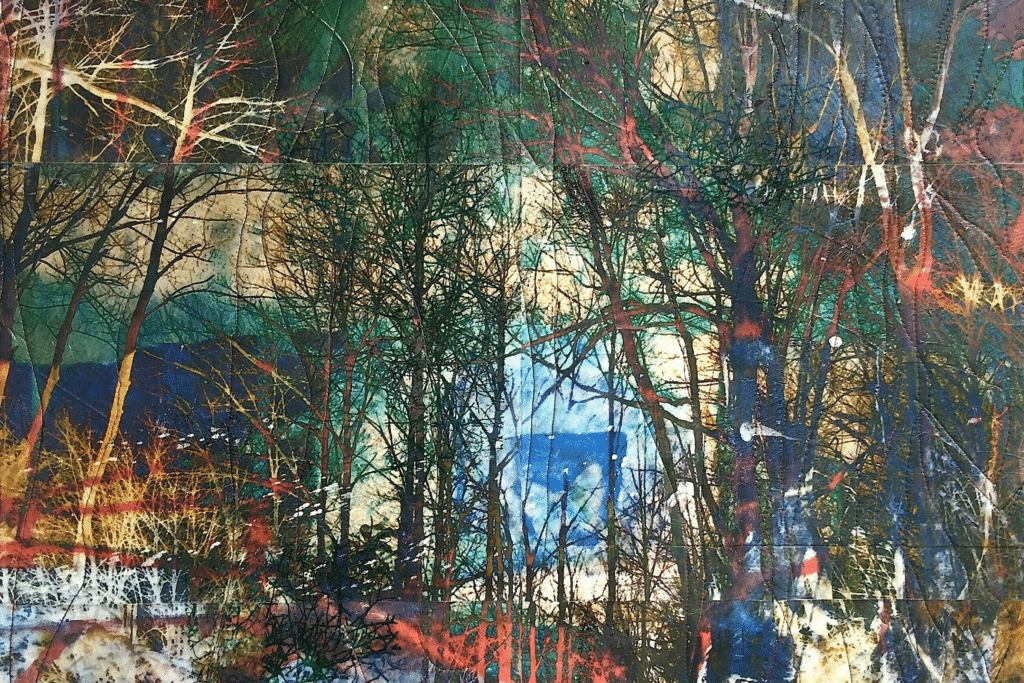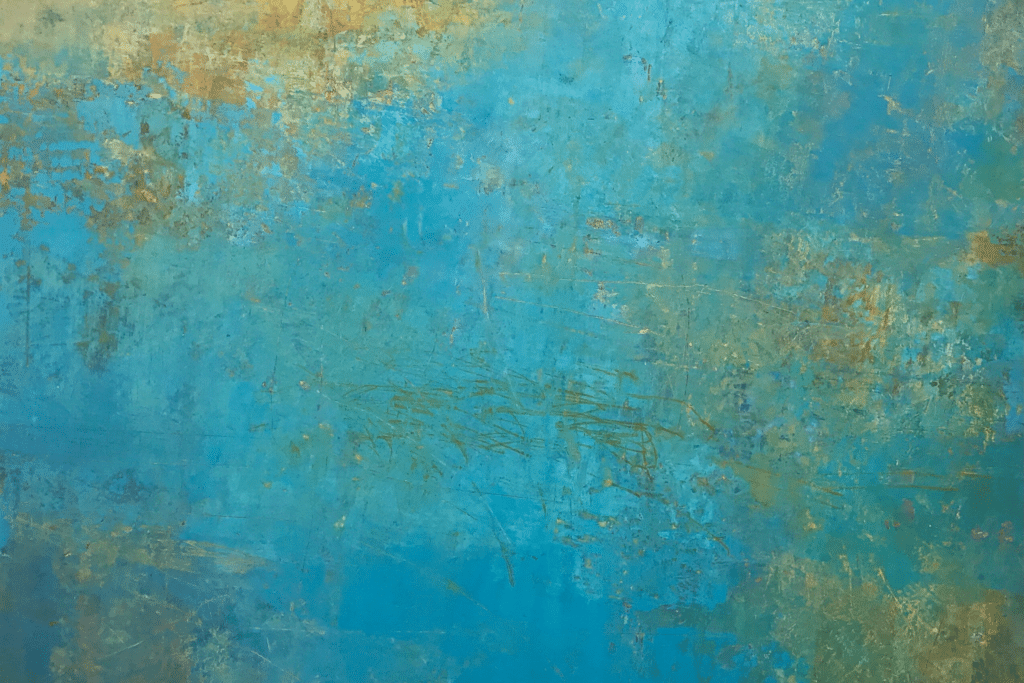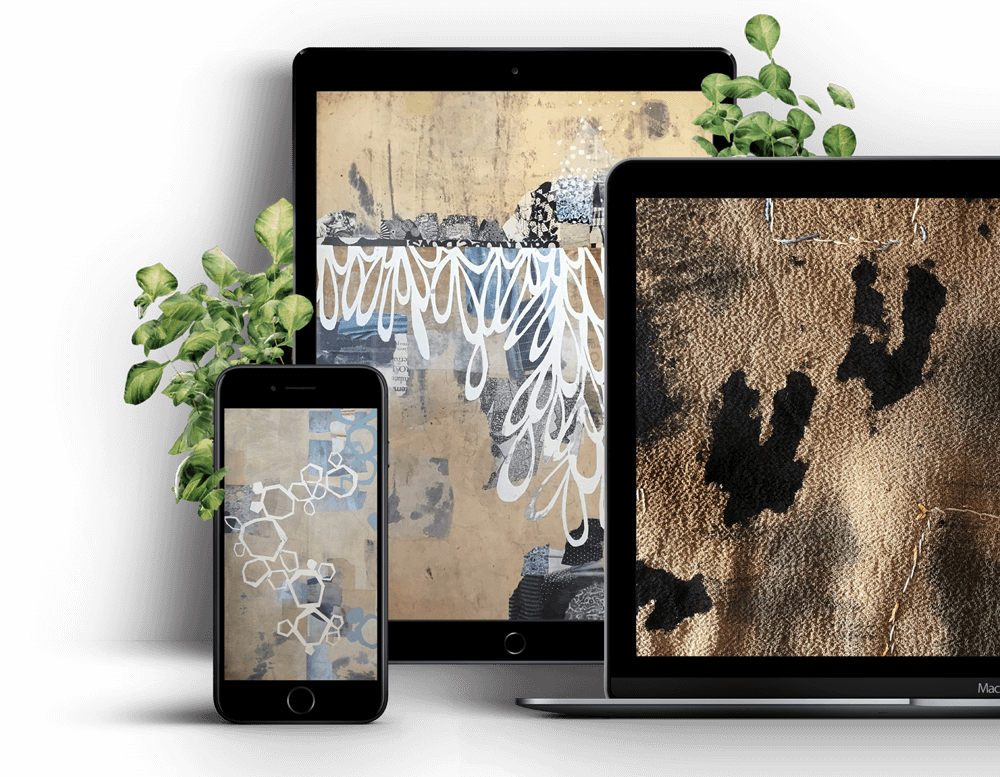Sally Hirst: Reworking and Repurposing
The art of UK-based Sally is all about reworking and repurposing. Fibre Arts Take Two learned more about Sally’s creative, can-do approach.
Sally Hirst’s Friday Feature Artist Interview can be found at the bottom of this page.
Reworking and repurposing are two of the words UK artists Sally Hirst often uses when describing her work. Sally creates paintings, prints and collages and can be found cutting and chopping them up. The urban environment’s textures, colours and structures inform her practice drawings and photographs of abandoned buildings and objects she finds.
Sally’s prints can be seen as paintings built in layers, each responding to what has gone before, and she describes herself as a painter and printmaker, a tutor who is nomadic, restless, curious, experimental, reverent, untidy and loud. But being an artist is where Sally feels at home.
Fibre Arts Take Two discovered more about Sally’s creative, can-do approach.
Reworking and repurposing
As much as reworking and repurposing have become vital to Sally’s work, these terms were not something she consciously set out with, “I wasn’t really aware of it until I did some deep reflections,” she says, “You do that every few years and ask, ‘Where am I? Where am I going? What have I done?’ I wasn’t aware of the repurposing until about three or four years ago.”
Self-reflection made Sally very aware of her passion for reworking and repurposing, “Once I was aware of it, of course, that’s what I do,” says Sally, “You just presume when you’re working that everyone else does that, and it’s only when you step back that you realise that is your identity, that is what you do, that is your subject matter, that is where you live. It has always been architecture and buildings and cities, even from a young child, but the repurposing, I think I only realised I was doing that fairly recently.”

High risk
Sally is the type of artist who jumps right in, but she knows that sometimes you have to temper such instincts, “I tend to have a very high-risk level,” she says, “and I tend not to have many parameters in terms of ‘oh, maybe you shouldn’t, so I tend to just launch in. It can be tricky. You can end up working, working and working, buying more stuff, trying, trying, trying when actually, at some point, you need to sit back and think about the ‘whys’, not just the process.
Being an educator has helped Sally to spend more time considering the process, “I think as an educator, she says, “when you’re teaching in colleges, you have to know it all. You’re the art teacher, and if a kid wants to do sculpture or printmaking, painting, or whatever it is, you have to be able to facilitate that. Yes, you have technicians, but on the whole, you have to understand where they’re coming from in terms of that media. I’ve always been gathering ideas and processes, but what I love now is how I’m cross-pollinating. The printmaking will inform the painting, and the painting will inform the printmaking, and they’ll both inform some collage. It’s like a party and a conversation that’s going on in my studio, and I’m just one of the people here. And that’s fabulous.”
Abstraction
Sally’s art strays strongly into the realm of the abstract, “I find when I’m teaching,” she says, “like my composition course, it is easy to play the shapes and lines and explore ideas around composition if it’s non-representational. But it is tough to get it right and make a piece that works as an abstract piece, without your horizon line or without something representational, because you don’t have anything to hang on to. As a landscape artist, you need a horizon line, and you can play above or below that to your heart’s content. You can be as awkward as you like if it’s all about the sky, if it’s all about blank. But when you’re moving away from those structures, it’s tricky.”
Sally also finds it liberating. She also notices abstraction gaining ground once again, “I think there’s been more of a resurgence in making abstract art,” says Sally, “But of course, abstraction has been around for a long time. Good abstractions have a timelessness. For me, it allows me to play.”
Texture
Texture plays a significant role in Sally’s work, “I think you’re either a texture buff, or you’re not,” she says, “I was doing lots of relief, printing, screen printing, and then I was trying to get texture into my screen prints. It wasn’t going to happen, so I had to find another way of working. I think you’re either into texture or not; you’re into colour or not. For me, if you think about all those compositional elements, line shape and texture are above if they have a hierarchy, are above colour. For other people, that would be the other way around.”

Not knowing
“There are different ways of approaching this idea of ‘not knowing’,” says Sally when asked about whether she likes to know what is coming or treasures not knowing, “Some people,” she says, “when you say not knowing, they think, ‘Oh, well, you’re just playing.’
No, no, no.
Not knowing the outcome and not knowing the basics are very different beasts, says Sally, “I end up with something that is well constructed and well composed because there is knowledge. But whilst I’m in the process, there’ll be points where I have no idea what will happen. I realised I would get bored easily if I knew what would happen. I want to maintain this place of not knowing for as long as possible. You still have to know what materials you’re using, what palette, what format or tools etc. But there’s a point where you can just put that to one side and play.”
‘Not yet’
Sally believes that young people are often not given the proper encouragement when developing their skills, “I think they’re often told no,” she says, “you’re not good enough, it’s not good enough. As a teacher, you tell a kid, ‘it’s not a no; it’s just not yet’.
For me personally, I felt that whilst, as a young person, there were lots of obstacles, I knew somehow deep down, I knew it was just a ‘not yet’; I knew that I would be able to do that at some point, and I did, with support from other people.”
Despite frustration at the time, Sally believes her freedom as a child helped her to grow as an artist, “I was angry and grumpy about the cards I had been dealt to a certain degree as a young person or a teenager,” Sally says, “but actually, when I reflected on that on a much deeper level, in my 30s, I realised that, that that’s what gives me the creativity. My relatively feral childhood meant that anything goes. I remember being about three or four, grabbing what I thought was clay from the garden and making a pot on my mom’s sofa. We were never told off, which can be tricky because kids need parameters. But as an adult, you need fewer of them. I realised it wasn’t a negative but an incredible positive because if anything goes, you can do anything. “

About the artist
Sally’s work is about journeys; those she takes and the journey that the artwork has been on in her studio. She creates paintings and works on paper, prints and collages. Each way of working informs the other and is often combined in a single piece.
The urban environment’s textures, colours and structures inform Sally’s practice. Drawings and photographs of abandoned buildings, objects she finds on her walks through a city, maps, rubbings and tracings of shadows all dictate the development of her work.
As well as being a professional artist educated to a Masters level, Sally is also a qualified teacher with many years of teaching experience. She currently teaches a range of online courses that enable her to reach students at all stages of their creative journey worldwide from her studio in Norwich, UK
Sally also co-coordinates an exhibition space called oneuppergoat.
Join Our Newsletter
OUR YOUTUBE CHANNEL
View our interviews and more on our Youtube channel!
OUR FACEBOOK GROUP
Join our Community and stay updated with our upcoming announcements!



